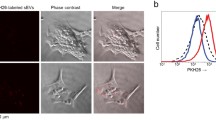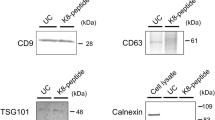Abstract
Small extracellular vesicles (SEVs) secreted from various cells are lipid bilayer vesicles, 30–150 nm in size, that carry proteins, nucleic acids, and lipids as cargos to other cells. They include exosomes, which are generated in multivesicular endosomes (MVEs) and secreted upon fusion of MVEs with plasma membranes and a part of microvesicles, which directly bud from plasma membranes. SEVs have attracted attention as diagnostic and drug discovery targets, since it has been demonstrated that SEVs are involved in the intercellular communication in many diseases and physiological phenomena such as cancer, neurodegenerative diseases, and immunity. There are five isolation methods for SEVs, which include ultracentrifugation, density gradient ultracentrifugation, polymer precipitation, affinity isolation, and size-exclusion chromatography. The affinity isolation, which isolates SEVs using magnetic beads conjugated with binding molecules such as antibodies, has the ability to isolate highly pure SEVs in character. However, the population of SEVs is limited by the binding molecules and it is difficult to elute intact SEVs from the antibody beads. In this chapter, we present a TIM4-affinity isolation method that targets phosphatidylserine (PS), a component of the SEV membrane. TIM4 binds to PS in a Ca2+-dependent manner, which enables the elution of intact SEVs from TIM4-beads in the presence of the chelating reagent ethylenediaminetetraacetic acid (EDTA). The TIM4-affinity isolation method helps overcome the disadvantages of the affinity isolation method and enables the isolation of heterogeneous SEVs at high purity. This method will facilitate the functional analysis of SEVs, development of diagnostic methods, and drug development of engineered SEVs.
Access this chapter
Tax calculation will be finalised at checkout
Purchases are for personal use only
Similar content being viewed by others
References
Hoshino A, Costa-Silva B, Shen T-L et al (2015) Tumour exosome integrins determine organotropic metastasis. Nature 527:329–335
Raposo G, Nijman HW, Stoorvogel W et al (1996) B lymphocytes secrete antigen-presenting vesicles. J Exp Med 183:1161–1172
Utsugi-Kobukai S, Fujimaki H, Hotta C et al (2003) MHC class I-mediated exogenous antigen presentation by exosomes secreted from immature and mature bone marrow derived dendritic cells. Immunol Lett 89:125–131
Lugini L, Cecchetti S, Huber V et al (2012) Immune surveillance properties of human NK cell-derived exosomes. J Immunol 189:2833–2842
Valadi H, Ekström K, Bossios A et al (2007) Exosome-mediated transfer of mRNAs and microRNAs is a novel mechanism of genetic exchange between cells. Nat Cell Biol 9:654–659
Janas AM, Sapoń K, Janas T et al (2016) Exosomes and other extracellular vesicles in neural cells and neurodegenerative diseases. Biochim Biophys Acta Biomembr 1858:1139–1151
Min L, Shen J, Tu C et al (2016) The roles and implications of exosomes in sarcoma. Cancer Metastasis Rev 35:377–390
Barger JF, Rahman MA, Jackson D et al (2016) Extracellular miRNAs as biomarkers in cancer. Food Chem Toxicol 98:66–72
Sterzenbach U, Putz U, Low L-H et al (2017) Engineered exosomes as vehicles for biologically active proteins. Mol Ther 25:1269–1278
Mathieu M, Martin-Jaular L, Lavieu G et al (2019) Specificities of secretion and uptake of exosomes and other extracellular vesicles for cell-to-cell communication. Nat Cell Biol 21:9–17
Colombo M, Raposo G, Théry C (2014) Biogenesis, secretion, and intercellular interactions of exosomes and other extracellular vesicles. Annu Rev Cell Dev Biol 30:255–289
Kowal J, Arras G, Colombo M et al (2016) Proteomic comparison defines novel markers to characterize heterogeneous populations of extracellular vesicle subtypes. Proc Natl Acad Sci U S A 113:E968–E977
Rider MA, Hurwitz SN, Meckes DG (2016) ExtraPEG: a polyethylene glycol-based method for enrichment of extracellular vesicles. Sci Rep 6:23978
Trajkovic K, Hsu C, Chiantia S et al (2008) Ceramide triggers budding of exosome vesicles into multivesicular endosomes. Science 319:1244–1247
Miyanishi M, Tada K, Koike M et al (2007) Identification of Tim4 as a phosphatidylserine receptor. Nature 450:435–439
Hanayama R, Tanaka M, Miwa K et al (2002) Identification of a factor that links apoptotic cells to phagocytes. Nature 417:182–187
Nakai W, Yoshida T, Diez D et al (2016) A novel affinity-based method for the isolation of highly purified extracellular vesicles. Sci Rep 6:33935
Author information
Authors and Affiliations
Corresponding author
Editor information
Editors and Affiliations
Rights and permissions
Copyright information
© 2022 Springer Science+Business Media, LLC, part of Springer Nature
About this protocol
Cite this protocol
Yoshida, T., Hanayama, R. (2022). TIM4-Affinity Methods Targeting Phosphatidylserine for Isolation or Detection of Extracellular Vesicles. In: Ayyar, B.V., Arora, S. (eds) Affinity Chromatography. Methods in Molecular Biology, vol 2466. Humana, New York, NY. https://doi.org/10.1007/978-1-0716-2176-9_2
Download citation
DOI: https://doi.org/10.1007/978-1-0716-2176-9_2
Published:
Publisher Name: Humana, New York, NY
Print ISBN: 978-1-0716-2175-2
Online ISBN: 978-1-0716-2176-9
eBook Packages: Springer Protocols




